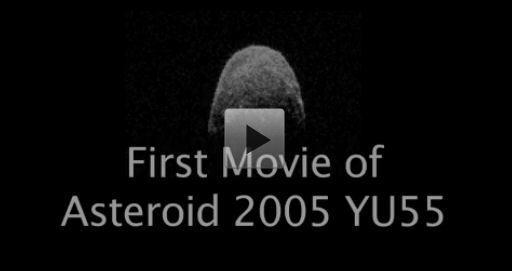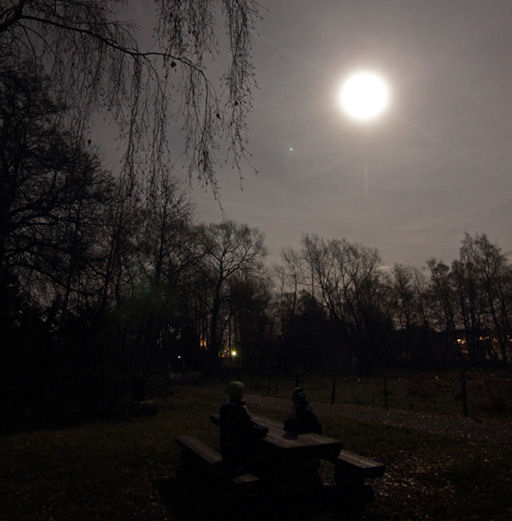Turn your cell phone into a field-tested satellite tracker. Works for Android and iPhone. | | | AURORA WATCH: High-latitude sky watchers should be alert for auroras on Nov. 10-11 when a coronal mass ejection could deliver a glancing blow to Earth's magnetic field. The source of the CME is a solar filament that erupted during the late hours of Nov. 7th. NOAA forecasters estimate a ~20% chance of polar geomagnetic storms. Auroras alerts: text, voice. ASTEROID MOVIE: Scientists working with the 70-meter Deep Space Network antenna at Goldstone, California, have generated a short movie clip of asteroid 2005 YU55, which passed through the Earth-Moon system on Nov. 8th. These are the highest-resolution radar images ever obtained for a near-Earth object: 
"The images achieve a resolution as fine as 3.75 meters and reveal a number of features that may be boulders on the surface, craters, and possibly ridges," says radar astronomer Lance Benner of JPL, principal investigator for the 2005 YU55 observations. Better data are in the offing. This first movie covers only a ~2 hour span on Nov. 7th. On Nov. 8th, the asteroid was even closer, and the giant Arecibo radar is now gathering data, too. "To date, we've seen less than one half of the surface, so we expect more surprises," says Benner. Stay tuned! amateur images: from David Cortner of Rutherford College, NC; from Ernesto Guido et al. using a remote-controlled telescope in New Mexico; from Thomas J Balonek of Hamilton, NY; from Mike Renzi of Lakeville, Massachusetts; from Chris Cook of Cape Cod, Massachusetts; from Steve Riegel of Albuquerque, NM; BRIGHT CONJUNCTION: Last night, sky watchers around the world witnessed a conjunction between Jupiter and the Moon. "It was very nice sight seeing the two bright heavenly bodies so close together," says P-M Hedén of Vallentuna, Sweden, who photographed his daughter and a friend admiring the view: 
The show's not over. The Moon and Jupiter are drifting apart but still less than 10o apart tonight. Look east after sunset for a conjunction so bright it shines through thin clouds and city lights. more images: from Tamas Abraham of Zsambek, Hungary; from Geir Øye of Ørsta, Norway
October 2011 Aurora Gallery
[previous Octobers: 2010, 2009, 2008, 2007, 2006, 2004, 2003, 2002] Potentially Hazardous Asteroids ( PHAs) are space rocks larger than approximately 100m that can come closer to Earth than 0.05 AU. None of the known PHAs is on a collision course with our planet, although astronomers are finding new ones all the time. On November 9, 2011 there were 1256 potentially hazardous asteroids. Recent & Upcoming Earth-asteroid encounters: | Asteroid | Date(UT) | Miss Distance | Mag. | Size | | 2011 FZ2 | Nov 7 | 75.9 LD | -- | 1.6 km | | 2005 YU55 | Nov 8 | 0.8 LD | 11.2 | 400 m | | 2011 UT91 | Nov 15 | 9.9 LD | -- | 109 m | | 1994 CK1 | Nov 16 | 68.8 LD | -- | 1.5 km | | 1996 FG3 | Nov 23 | 39.5 LD | -- | 1.1 km | | 2003 WM7 | Dec 9 | 47.6 LD | -- | 1.6 km | | 1999 XP35 | Dec 20 | 77.5 LD | -- | 1.0 km | | 2000 YA | Dec 26 | 2.9 LD | -- | 80 m | | 2011 SL102 | Dec 28 | 75.9 LD | -- | 1.1 km | Notes: LD means "Lunar Distance." 1 LD = 384,401 km, the distance between Earth and the Moon. 1 LD also equals 0.00256 AU. MAG is the visual magnitude of the asteroid on the date of closest approach. | | The official U.S. government space weather bureau | | | The first place to look for information about sundogs, pillars, rainbows and related phenomena. | | | Researchers call it a "Hubble for the sun." SDO is the most advanced solar observatory ever. | | | 3D views of the sun from NASA's Solar and Terrestrial Relations Observatory | | | Realtime and archival images of the Sun from SOHO. | | | from the NOAA Space Environment Center | | | the underlying science of space weather | | 
